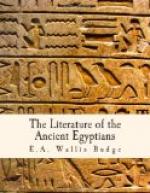of him the wrath of the angry man dieth down.
He speaketh the gentle word at the moment of strife.
He is a pleasant breeze to him that appealeth to him.
He delivereth the helpless one. He is the wise
(?) god whose plans are beneficent.... He is
more helpful than millions to the man who hath set
him in his heart. One warrior [who fighteth] under
his name is better than hundreds of thousands.
Indeed he is the beneficent strong one. He is
perfect [and] seizeth his moment; he is irresistible....
All the gods are three, Amen, Ra and Ptah, and there
are none like unto them. He whose name is hidden
is Amen. Ra belongeth to him as his face, and
his body is Ptah. Their cities are established
upon the earth for ever, [namely,] Thebes, Anu (Heliopolis),
and Hetkaptah (Memphis). When a message is sent
from heaven it is heard in Anu, and is repeated in
Memphis to the Beautiful Face (
i.e. Ptah).
It is done into writing, in the letters of Thoth (
i.e.
hieroglyphs), and despatched to the City of Amen (
i.e.
Thebes), with their things. The matters are answered
in Thebes.... His heart is Understanding, his
lips are Taste, his Ka is all the things that are
in his mouth. He entereth, the two caverns are
beneath his feet. The Nile appeareth from the
hollow beneath his sandals. His soul is Shu,
his heart is Tefnut. He is Heru-Khuti in the
upper heaven. His right eye is day. His left
eye is night. He is the leader of faces on every
path. His body is Nu. The dweller in it is
the Nile, producing everything that is, nourishing
all that is. He breatheth breath into all nostrils.
The Luck and the Destiny of every man are with him.
His wife is the earth, he uniteth with her, his seed
is the tree of life, his emanations are the grain.”
HYMNS TO
THE SUN-GOD
The following extracts from Hymns to the Sun-god and
Osiris are written in the hieratic character upon
slices of limestone now preserved in the Egyptian
Museum in Cairo.
“Well dost thou watch, O Horus, who sailest
over the sky, thou child who proceedest from the divine
father, thou child of fire, who shinest like crystal,
who destroyest the darkness and the night. Thou
child who growest rapidly, with gracious form, who
restest in thine eye. Thou wakest up men who
are asleep on their beds, and the reptiles in their
nests. Thy boat saileth on the fiery Lake Neserser,
and thou traversest the upper sky by means of the
winds thereof. The two daughters of the Nile-god
crush for thee the fiend Neka, Nubti (i.e. Set)
pierceth him with his arrows. Keb seizeth (?)
him by the joint of his back, Serqet grippeth him
at his throat. The flame of this serpent that
is over the door of thy house burneth him up.
The Great Company of the Gods are wroth with him,
and they rejoice because he is cut to pieces.
The Children of Horus grasp their knives, and inflict
very many gashes in him. Hail! Thine enemy
hath fallen, and Truth standeth firm before thee.




